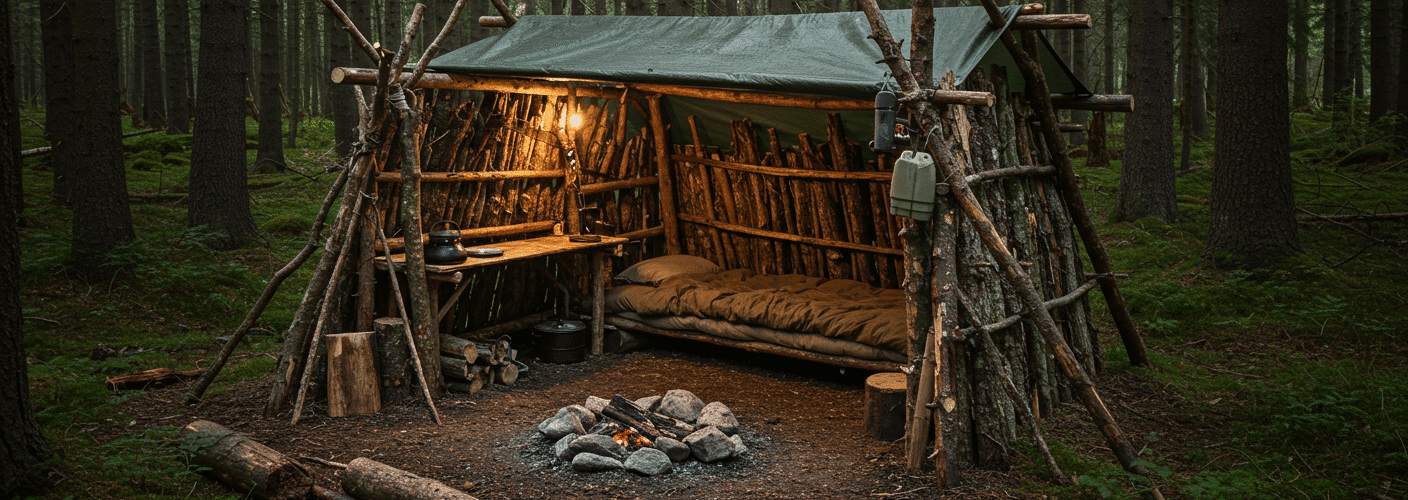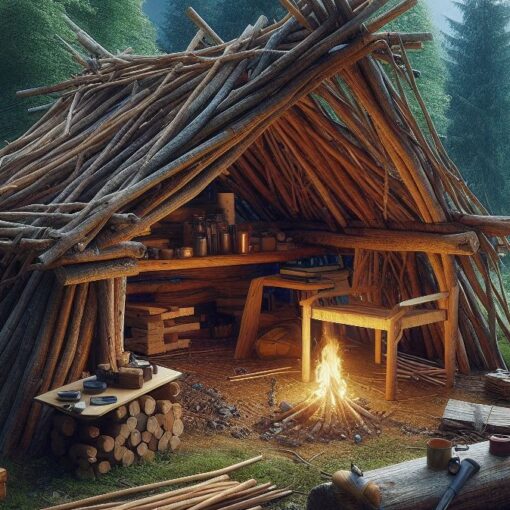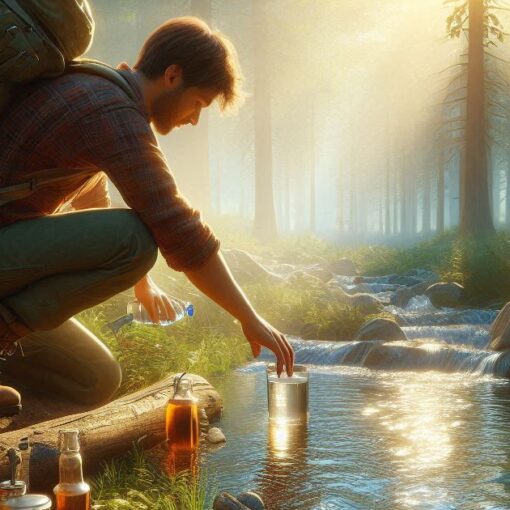Please Note: This post may contain affiliate links. If you click one of them, we may receive a commission at no extra cost to you. As an Amazon Associate, I earn from qualifying purchases.
What do you think of when you think about outdoor activities? Is it the thrill of hiking through thick woods, the thrill of camping beneath a starry sky, or maybe the fragrance of roasted marshmallows? All of it sounds great, but we should remember that nature may be unpredictable. So, if you’re going on a weekend trip or a long trip into the wilderness, you need to know some good outdoor survival skills. Believe me, you’ll be glad you did!
Top Takeaways and Key Concepts
- Study terrain and wildlife before trips to avoid danger and navigate confidently.
- Pack only essential and activity-specific gear to travel light and stay prepared.
- Drink water regularly and bring purification tools to prevent dehydration.
- Learn simple shelter-building and insulation methods to stay safe in harsh weather.
- Carry first aid supplies and practice basic skills to handle injuries calmly.
Summary of This Article
This article emphasizes the importance of outdoor survival skills for anyone exploring nature, from casual hikers to seasoned adventurers. It explains why understanding your surroundings, using both digital and traditional navigation tools, and preparing for emergencies are crucial to staying safe. Smart packing with essential tools and hydration planning can prevent common outdoor problems. The article also stresses survival basics like building shelter, starting fires, and using natural insulation for warmth. Finally, it highlights the need for first aid knowledge to manage injuries and boost confidence outdoors. With preparation, awareness, and the right mindset, outdoor adventures become safer and more enjoyable.
Video of This Article
Know Your Surroundings

Before you ever step foot on a trail, you should learn about the place you’re going to. I all, who wants to be lost in the middle of nowhere? Not me! Take a map (yep, those old-fashioned paper things) and read it like it’s your favorite comic book. When you need to find your way, look for landmarks and paths. These will be your best friends.
Learning about the animals that live near you can also influence the game. Knowing what animals are around can help you get ready better. For instance, if you’re heading into bear country, understanding how to hang food properly will keep those furry giants away from your dinner. And let’s be honest: no one wants to give their granola bars to a bear!
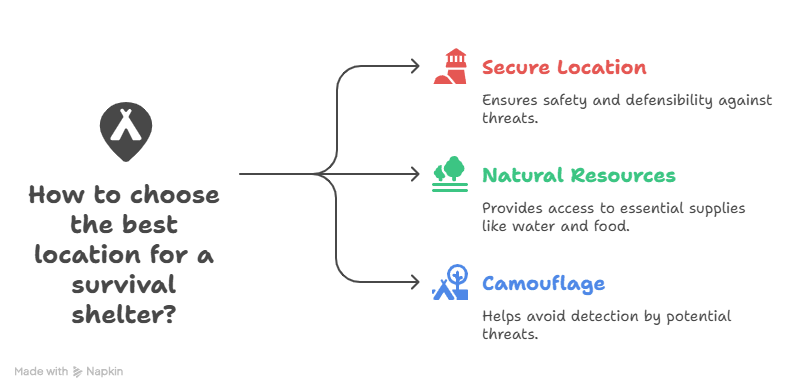
And speaking of tools for getting around, let’s get a little deeper into the tech side of things! It’s easy to depend just on GPS devices and mobile apps in this day and age of smartphones and other technologies. They can be great for giving you up-to-date information on where you are, how to get there, and even local places of interest. You can zoom in on maps, identify trails, and sometimes even get notifications when the weather changes. Sounds good, right? But wait a minute; there are some things you should know.
First of all, technology is very useful, but it can also be touchy. You’re lost in the woods after a long journey and attempting to find your way back when suddenly—bam! It takes less time for your phone battery to fail than it does for you to say, “Where’s my charger?” Or maybe you’re in a place where there isn’t any signal at all. It’s like being in a bad dream where you can’t get help or look up directions on Google Maps. That’s why it’s so important to have a backup plan!
Now let’s speak about how to find your way around the old-fashioned way. I know what you’re thinking: “Why do I need a map when I have an app?” Well, here’s the thing: maps don’t run out of batteries or lose their signal! It can feel like you’re in survival school when you learn how to read a topographic map and use a compass, but trust me, you’ll feel like a wizard when you do it right.
So, my recommendation is to always have both digital and paper maps with you when you go on expeditions. Keep your beloved paper map and compass in your backpack as a backup. And if you’re feeling really ambitious, practice using them before heading out on your trip! You’d be shocked how good it feels to get around without having to use technology all the time.
Lastly, don’t forget to get maps that you can use without an internet connection before you leave! A lot of apps have this capability, which lets you use maps without an internet connection when you’re out in nature. It’s like bringing extra snacks: when things become rough, you’ll be glad you have additional choices.
In short, use technology to help you get around, but don’t forget its limits. Get both high-tech tools and old-fashioned navigation abilities so you’re ready for anything that comes your way!
Pack Smartly
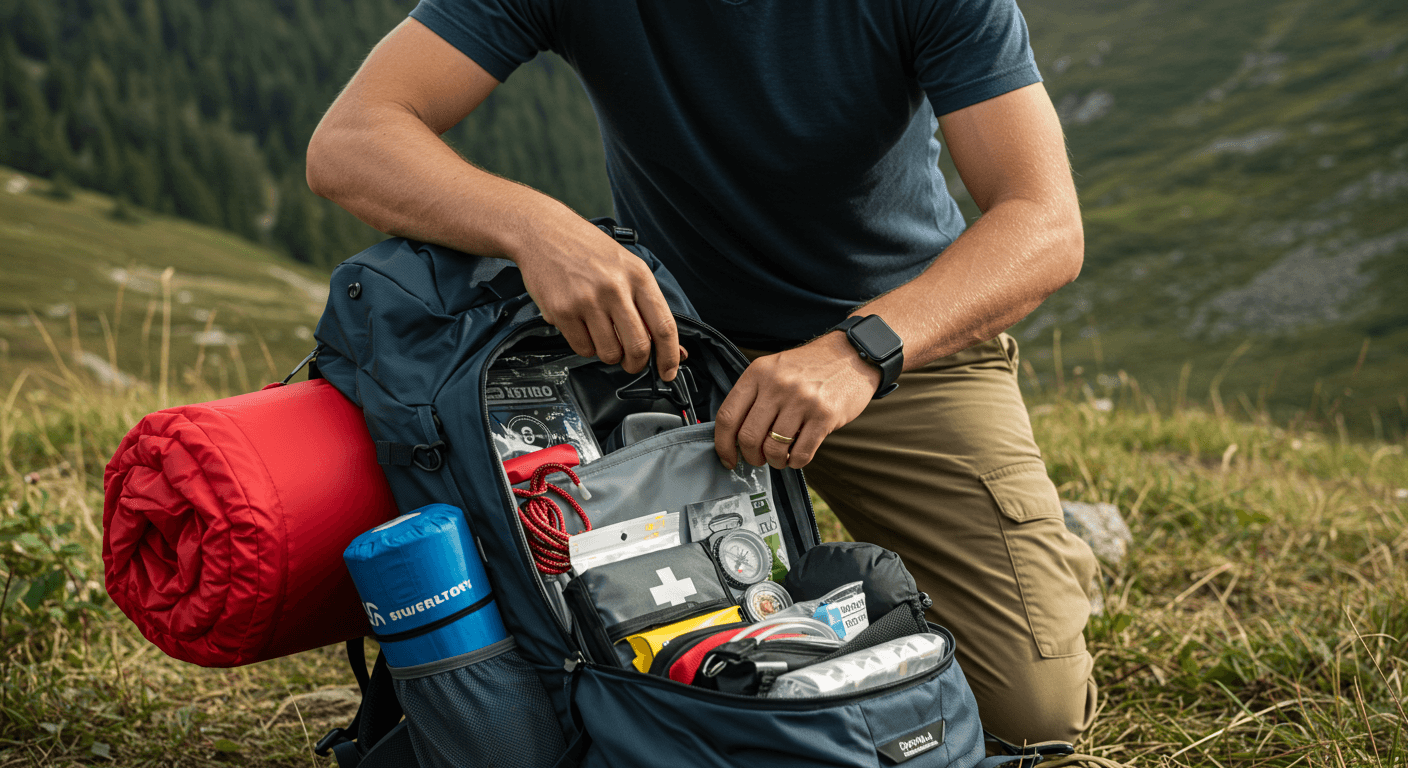
Now that you know where everything is, let’s talk about packing. To be honest, this is where a lot of folks go wrong. You could believe that putting every item you own in your backpack is a good idea, but trust me, it will only make your back hurt and make you feel bad.
Instead, concentrate on the basics! The “10 Essentials” list is a good rule of thumb. It includes a map, compass, water purification system, first aid kit, multi-tool or knife (because who doesn’t want to feel like Bear Grylls?), fire starter supplies (matches or a lighter), a flashlight with extra batteries (you’ll thank me at night!), food (think energy bars), an emergency blanket (it packs small but keeps you warm), and signaling devices like whistles.
Let’s talk about how to make your pack unique for the trip you’re going on, though. This is where it gets interesting! Don’t just throw in random things that might never see the light of day if you’re going fishing. Instead, think about what you really need to have a good day, or even a fun day!
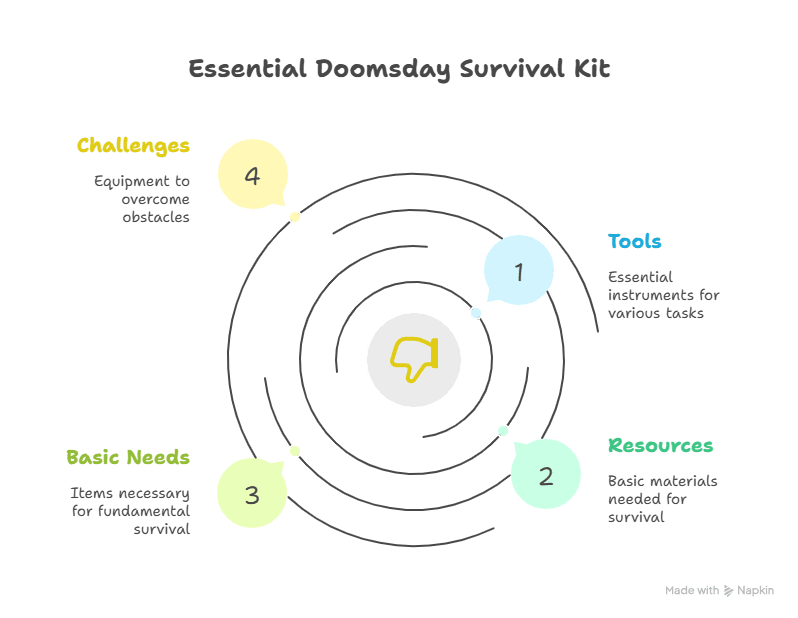
If you’re going fishing, for example, it’s obvious that you should have a tackle box full of lures and hooks. You should bring a sturdy fishing pole that feels good in your hands and maybe even a portable chair. Let’s be honest: it can take a while for fish to bite, so comfort is vital! Don’t forget sunscreen; no one wants to look like a lobster after spending a long day on the water. And since we’re talking about customisation, how about adding your favorite snacks? When you’re sitting by the lake, a few granola bars or some trail mix can really lift your spirits.
Let’s change the subject now and talk about hunting. If that’s more your style, you should replace those fishing lures with things like calls or decoys. Instead of standing out like a sore thumb, think about what will help you blend in with nature (and trust me, bright colors aren’t going to help you here). Along with any appropriate permits or licenses, camouflage clothing should be at the top of your list. Nothing ruins an outdoor adventure faster than running into game wardens when you weren’t expecting them!
When you look at everything, the goal here is to be efficient and useful at the same time. It’s important that everything in your pack has a function that has to do with what you’re doing. Why carry around gear that isn’t useful if you’re going through tough terrain instead of casting lines or tracking animals? Choose lightweight gear that lets you move quickly and keeps you ready for everything Mother Nature throws your way.
And don’t forget about safety! Always pack first aid items that are specific to your hobbies. For example, if you’re hiking, bring extra band-aids for scratches, and if you’re near the lake, bring mosquito repellant. You’ll be glad you did later. No one likes to be taken off guard when something unexpected happens.
As you get ready for your next excursion, take a moment to think about what you’ll really need based on where you’re going and what you’ll be doing. Making your pack unique makes it easier to grab and leave without having to think twice about it. Also, it feels great to know that you did everything perfectly!
Stay Hydrated
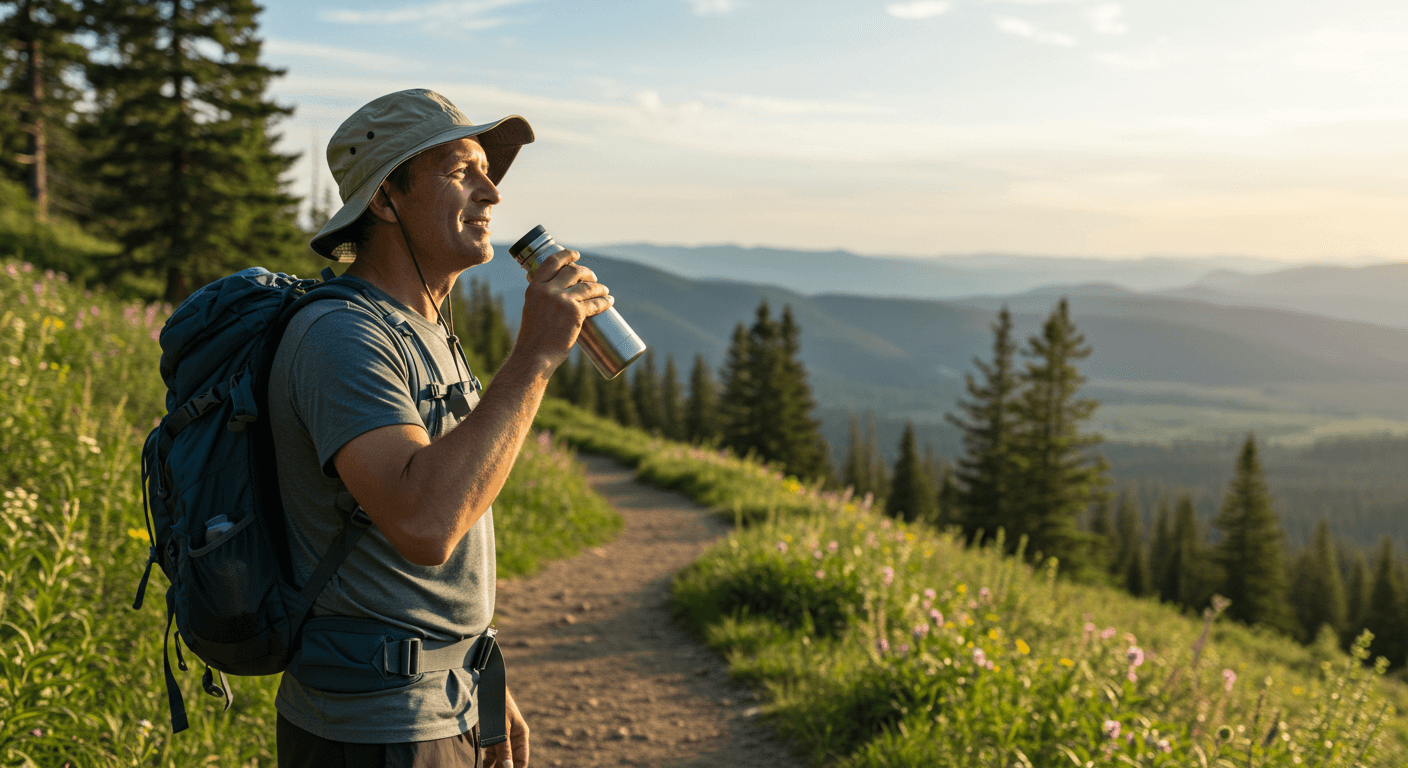
We need to talk about being hydrated since nothing destroys being outside faster than being thirsty! Out there, water is life; it’s just as important as finding Wi-Fi at a coffee shop. Always bring enough water for the whole journey, plus a little extra just in case something goes wrong.
You might want to buy portable water filters or purification tablets if you’re going on a hike where there aren’t any good water sources nearby or if you just want to be extra daring. They’re light and could keep you from drinking creek water that looks like something out of a horror movie.
It’s interesting that hydration should be at the top of your list of things to do while you’re out in nature, even though it’s so easy to get caught up in the excitement of seeing a rare deer or climbing a beautiful peak. It’s like forgetting to charge your phone before a big vacation; you really don’t want to end up with a dead battery when you need it the most!

Picture this: you’re walking up a beautiful trail with tall trees and chirping birds all around you. You feel like the king or queen of the world. You forgot to drink water because you’re having so much fun. Before you realize it, your energy levels drop faster than a lead balloon. When you’re thirsty and dragging your feet, that beautiful scenery doesn’t look as striking anymore. So, believe me when I say that being hydrated is very important for keeping your spirits high!
Think about putting reminders on your phone to help you keep on top of your hydration. At first, it can seem funny, like having a digital babysitter, but I swear it works! You may set an alarm every hour or so to remind you to drink from your water bottle. When you’re busy taking pictures or talking to friends about how great everything looks, it’s easy to forget about it. Those little pushes can help you stay drinking all day.
Now let’s discuss about how much water we really need. The “8×8 rule” says you should drink eight 8-ounce glasses of water every day. But if you’re sweating like it’s July in Texas, you’ll need even more! In warm weather, a decent rule of thumb is to drink around half a liter every hour of moderate exertion. If you’re going uphill, though? Then double that! Your body will appreciate you later when you don’t have to fight off tiredness or heat exhaustion.
It’s also important to note that hydration doesn’t simply come from plain water; it can come from other places as well! You might want to bring some snacks that will keep you hydrated, including juicy fruits (watermelon, anyone?) or vegetables that are high in water, like cucumbers and celery sticks. These tasty choices not only satisfy your thirst, but they also give you extra nutrients that will keep your energy up.
And speaking of keeping spirits high, nothing elevates your spirits like bringing out a cold drink in the shade after hours of hiking through the woods. Imagine this: You find a nice area beneath some trees, open that thermos full of iced tea or lemonade, and you’ll feel better right away! Also, sharing drinks and food with companions makes those particular memories that make outdoor outings so much fun.
So, keep in mind that even if nature provides a lot of amazing things to see and do, dehydration can ruin your fun! Make drinking water entertaining and interesting by setting reminders on your phone and bringing delectable snacks and lots of water with you. After all, drinking enough water keeps your spirits high and your energy levels up as you enjoy all the beauty of the great outdoors!
Build Shelter Like A Pro
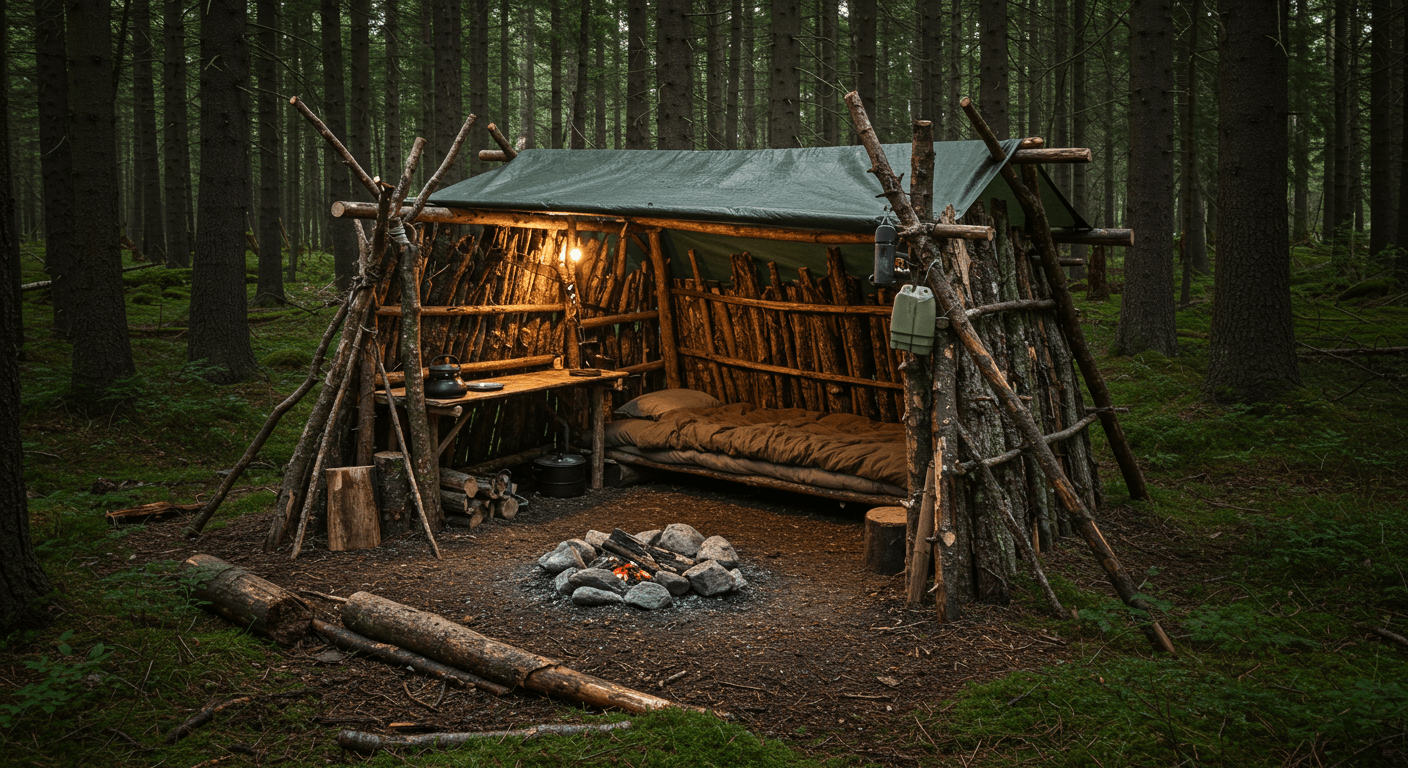
Think about this: It’s becoming dark outside and the temperature is falling faster than my desire to do laundry. What do you do? You make a place to live! Making a safe spot to sleep can mean the difference between appreciating the beauty of nature and shivering all night long, wishing you had stayed home on your couch.
You don’t need fancy tools; a simple tarp may do a lot if you know how to utilize it. Look for natural structures like fallen trees or rock overhangs; they are great at keeping you safe from wind and rain. It will also help to know how to tie basic knots so that tarps stay put and don’t blow away in storms.
But seriously, don’t forget about insulation choices when you’re out in the woods! You might assume that all you need is a nice sleeping bag or a fancy thermal blanket, but nature has some pretty cool tricks in her sleeve. Putting leaves or pine needles around your temporary shelter can make a huge difference in how warm you stay. It feels like you have a secret weapon against the cold!
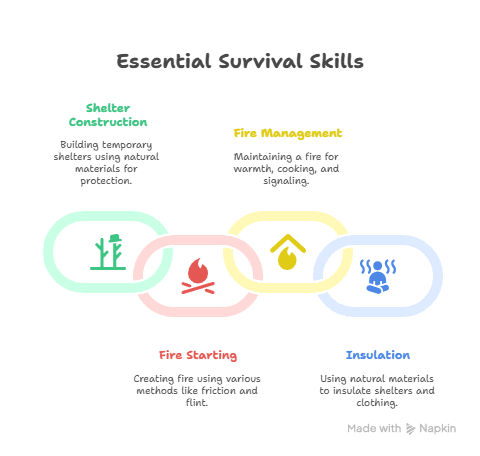
Imagine this: after a long day of exploring, you’re buried inside your little shelter and the temperature starts to drop faster than I want to get up early on the weekends. Instead of shaking and wishing for your mom’s hot chocolate, picture yourself surrounded by a thick coating of pine needles or leaves. These natural materials are great insulators because they trap air pockets that keep heat inside. It’s like putting on a blanket that Mother Nature made herself!
Now, this is where it gets really interesting: those pine needles and leaves aren’t just for show; they actually work better than most modern blankets! When you arrange them right, they make a barrier that keeps the chilly air outside and the warmth near to your body. Who knew that all those times I complained about raking leaves would help me in the wild?
But hold on—there’s more! These natural materials not only keep you warm, but they may also be used for other things. For example, if you need more cushioning on the ground to be comfortable (since sleeping on rocks isn’t exactly five-star luxury), putting them under you can assist protect your body. It will feel like you’ve made your own small home in the woods.
And don’t forget to use branches and debris from fallen trees to form walls around your shelter! When you add those magnificent leaves or pine needles we talked about earlier, this will not only assist block the wind, but it will also add another layer of insulation. Think of it as building a wall against the colder weather.
It’s also important to remember that different kinds of plants provide varied levels of insulation. Evergreen branches are great since they stay green all year and keep their shape nicely, even when you stack them together to make a wall! At the same time, broadleaf plants can also cover a lot of ground. Take a time to look about you. Nature gives us everything we need if we know how to use it!
Finally, even while building your leafy sanctuary may seem like fun at first (and yes, I’ve been known to get carried away erecting leaf forts), remember that every little amount helps you remain warm on cold evenings outside. So go ahead and let your inner child out by piling those leaves high! Not only will you be warm, but you’ll also be using some old survival skills.
In short, don’t forget how important good old-fashioned insulation is whether you’re camping or hiking in chilly places. You may be warm and comfortable without having to carry along heavy gear by using natural materials like leaves and pine needles. So the next time you plan an outdoor expedition in the fall or winter, bring some snacks and some ingenuity. You’ll be glad you did!
Fire Starting Fundamentals
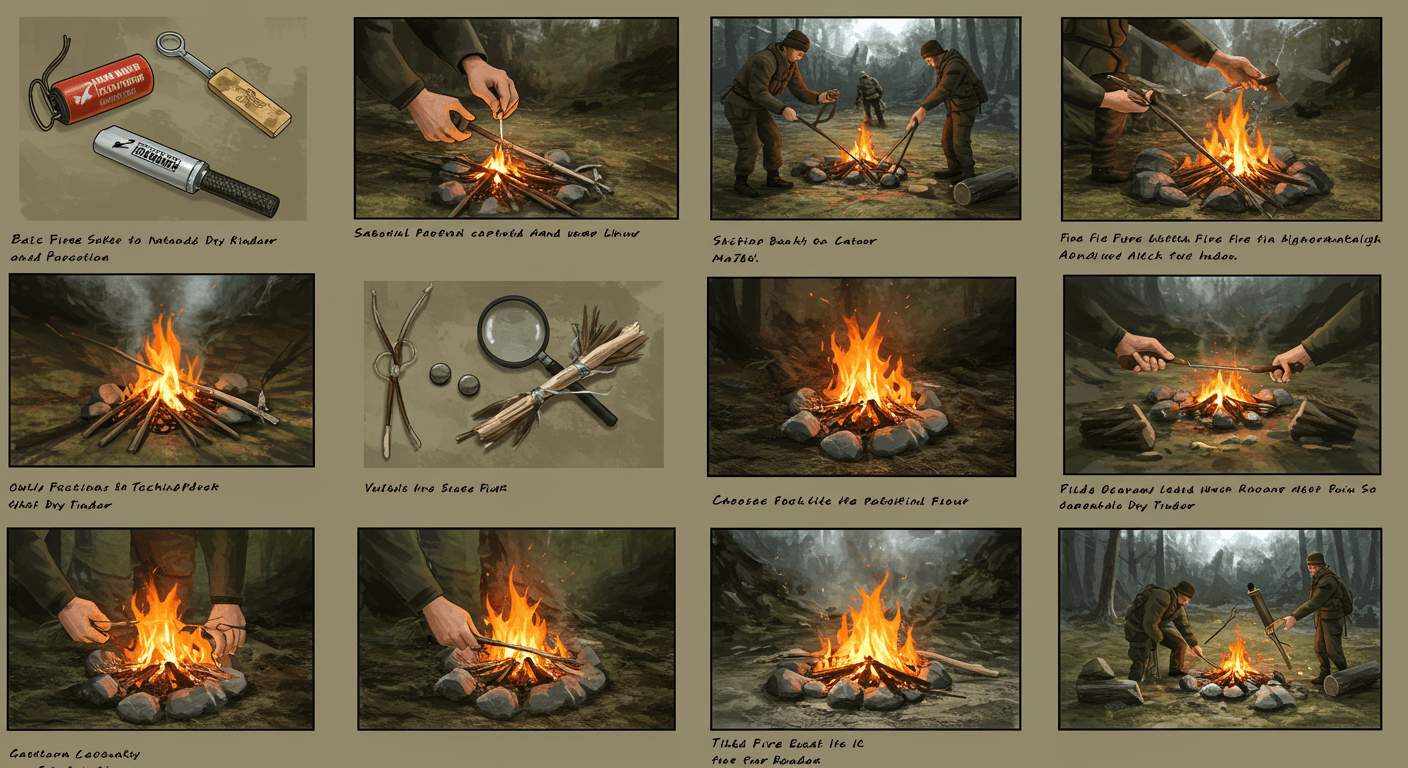
Ah yes, the magical thing that is fire! Gathering around a fire after a long day outside is one of the most basic things you can do. It warms both your heart and your body! But it’s not always easy to start one unless you’ve practiced first.
To get things going right away, gather tinder (such dry grass or bark), kindling (small sticks), and bigger logs before you try to start the fire. That way, everything is ready when the sparks fly! You might think that using waterproof matches is overkill, but believe me, they will rescue the day when it rains unexpectedly.
I learned this from experience: not all flames need regular wood fuel. Sometimes, fatwood sticks perform great since they have a lot of resin in them. If you’ve ever been in a rainy forest and looked at wet logs and thought, “How am I supposed to start a fire?” let me tell you: fatwood is your new best buddy!
So, what is fatwood? It’s practically the Superman of kindling. It derives from the stumps of pine trees that have been naturally filled with resin over time. This resin is like nature’s own fire starter; it makes fatwood burn faster than I can get excited about campfire s’mores. If the weather doesn’t cooperate, all you have to do is strike a match or light your lighter, and you’re on your way to a raging fire.
Now, here’s the best part: fatwood can light up even when it’s wet outside because of that sticky resin. Do you ever notice that everything feels wet after a sudden rain shower? If you sit by the cold hearth and think about your life choices, traditional wood might just sit there and sulk in its wet state. But not fatwood! Even if the chances are against it, it will burn brilliantly and fiercely.
One time while we went camping, it started to rain out of nowhere. My companions were ready to give up (and by “give up,” I mean they were looking at their wet sandwiches with dread). But I had some reliable fatwood sticks with me! In just a few hits with my trusty fire starter and some careful placing of those beautiful wood, we had flames dancing in no time. Instead of shivering under tarps, everyone was suddenly crowded around the warmth!
Fatwood is also easy to prepare, which is another great feature about it. Fatwood is typically tiny enough to use directly out of the container or straight from nature if you find some decent pieces while hiking. This is different from having to chop and split larger logs, which can be as irritating as trying to open a hard jar of pickles. Just tear off what you need and get ready to go!
But safety is important, so always make sure you’re obtaining your resources in a safe and legal way. Some places may not let you collect natural resources like fallen branches or certain kinds of wood, so make sure to read the rules in your area before you start acting like a lumberjack.
Also, if you want to get your fire going even faster, you can mix your fatwood with some dry leaves or twigs. The combination is a great way to start a fire that will make you feel like Bear Grylls in no time (without the scary survival scenarios). We want flames, not an explosion, so don’t overload it!
In short, if you’re going on an outdoor expedition, especially if the weather is unpredictable, think about bringing some fatwood sticks with you. They are light, yet they can start flames quickly and easily. You’ll be delighted you have this little jewel in your supplies, whether you’re roasting marshmallows or just warming up after a long journey.
First Aid Basics

Last but not least, we mustn’t forget about first aid knowledge because accidents can happen even in paradise. Being ready means that these small problems, like blisters from new boots or small cuts while whittling wood for roasting hot dogs, won’t ruin anything!
Make a small first aid kit with band-aids (the colorful ones make it less serious!), antiseptic wipes (no one likes infections!), and gauze pads for bigger boo-boos. You could even add some pain relievers in case someone gets into poison ivy and needs them!
I also think that everyone will feel better if they practice basic first aid skills ahead of time. Picture being in the great outdoors, surrounded by the splendor of nature, when someone trips over a rock and scrapes their knee. You don’t have to freak out or run around like a chicken with its head cut off; you can calmly step in and take care of the problem. Adventurers are better off knowing how to cure injuries than being left to thrash around, trying not to scream at bugs buzzing around their ears.
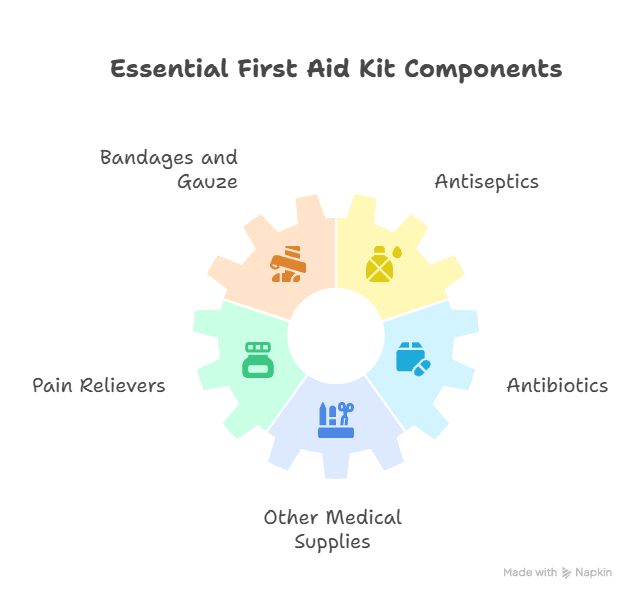
First aid isn’t just for the big things; it can help with everything from little cuts and scratches to bigger problems like sprains or insect bites. And let’s be honest: those annoying bugs have a way of coming up unannounced when you’re outside enjoying the great outdoors. Knowing how to cure bites can help you keep your cool! You can ease that itchy pain instead of letting it ruin your day.
So, where do we begin? First things first, get to know the important things that should be in your first aid bag. A kit that is well-stocked can save your life. You should have sticky bandages in different sizes, antiseptic wipes to disinfect wounds (because no one wants dirt in an open scrape), gauze pads, and some medical tape. Also, don’t forget about painkillers like ibuprofen or acetaminophen. They may make a grouchy camper happy faster than you can say “campfire s’mores!”
The next step is to learn how to use these products well. I remember attending a basic first aid class where we practiced wrapping each other’s arms like we were getting ready for a wrestling match. It was funny, but it was also quite helpful. You will feel better prepared for those small accidents that are sure to happen on trips if you know how to clean and bandage wounds appropriately.
A lot of people don’t realize how important it is to cure blisters until they can’t walk because they feel like they’ve stepped on scorching coals! Blisters are common when shoes don’t fit right or when you go on lengthy walks without the right socks. The most important thing is to learn how to avoid them by choosing the right shoes. But if you do get one, learning how to drain it correctly and protect it thereafter will keep you from having to limp home instead of hiking.
And while we’re on the subject of practice, why not make it fun? Take your friends or family camping outside and use part of the vacation to teach them how to conduct first aid. You may build up situations where someone pretends to get harmed (in a safe way) and others practice how to act as if it were real life. This will not only boost the group’s confidence, but it might also lead to some amusing moments that make serious themes less serious.
Lastly, always keep in mind that being cool is half the battle when you’re hurt outside. When there is an emergency, people are more likely to follow your lead if you stay calm. Tell everyone that little injuries are just part of the fun. After all, what’s camping without a few scratched knees?
In the end, taking the time to learn basic first aid skills before going into the wild is a great way to give everyone piece of mind. Having this information gives travelers confidence and lets them enjoy their surroundings without worrying about what can go wrong. They can cure small scrapes and bruises, insect bites, and blisters. So gather your pals together and get ready to study while having fun. It could make a significant difference on your next big excursion!
In conclusion—and I mean this sincerely—outdoor survival tips aren’t just helpful—they’re essential for making every adventure enjoyable instead of terrifyingly chaotic experiences we’d rather forget!
Suggested Resources
Outdoor Survival Skills
https://www.wilderness-survival.net/outdoor-survival-skills/
The Ultimate Guide to Wilderness Survival
https://www.survivalsullivan.com/ultimate-guide-wilderness-survival/
Survival Tips: What You Need to Know
https://www.rei.com/learn/expert-advice/survival-tips.html

Kevin Collier is a seasoned outdoor enthusiast and writer for Trekbug.com, specializing in outdoor adventures, survival strategies, and prepping insights. With a deep love for nature and a commitment to self-sufficiency, Kevin empowers readers to embrace the wilderness confidently. He shares valuable tips, practical techniques, and inspiring stories, helping both novice and experienced adventurers develop essential skills for surviving and thriving in the great outdoors.

